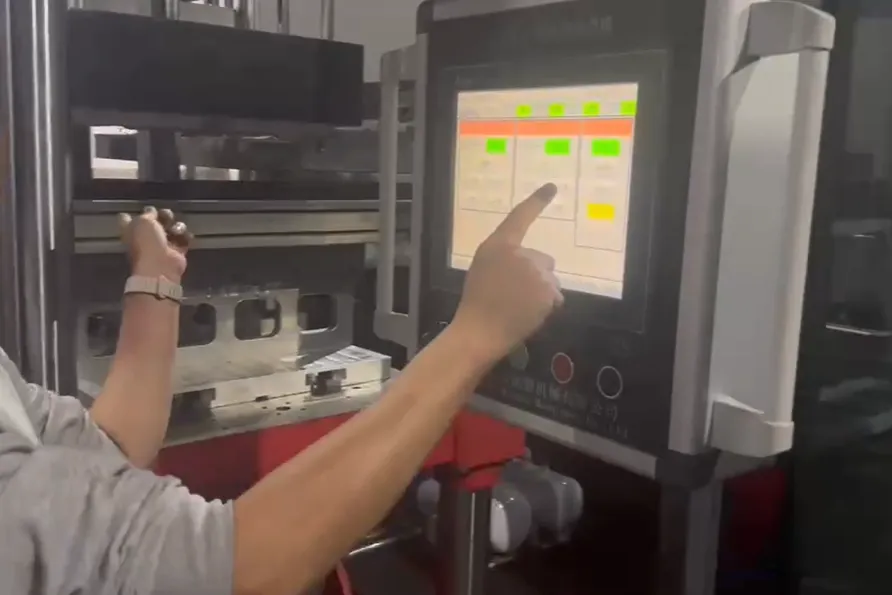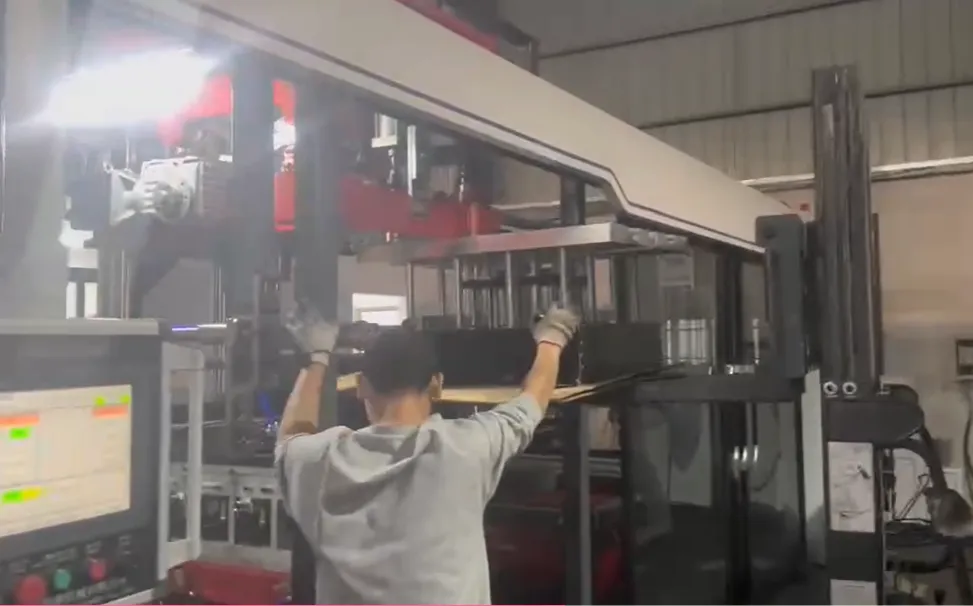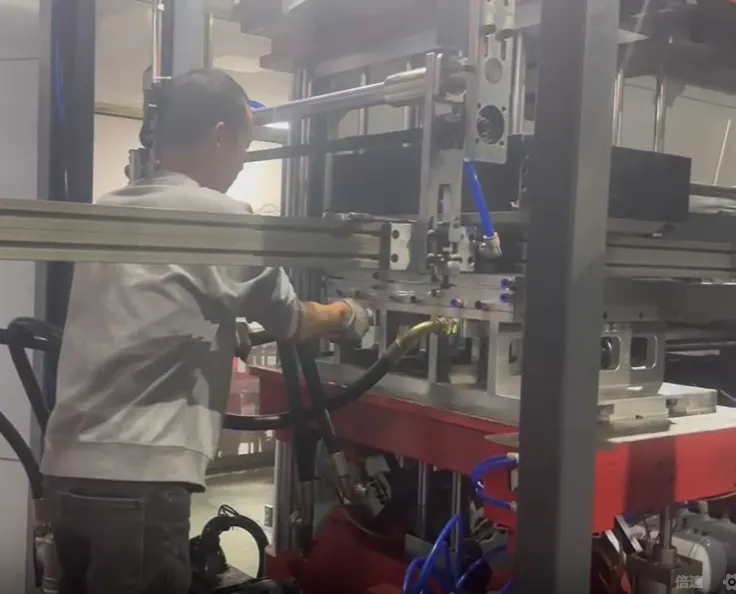Introduction: What Is an Automatic Mold Alignment System
In the competitive landscape of plastic packaging manufacturing, achieving high productivity while maintaining consistent quality is the ultimate goal. One of the key enablers of this balance in thermoforming multi-station machines is the automatic mold alignment system.
An automatic mold alignment system is a precision automation solution that ensures molds at each station—forming, cutting, stacking—are correctly aligned in both position and timing. Misalignment, even in millimeters, can create serious quality issues, slow down production, and cause mechanical wear.
This system replaces traditional manual alignment methods with an intelligent, feedback-driven, automated mechanism, providing real-time corrections to mold positions. It is especially critical in multi-station thermoforming setups, where each module must work in perfect coordination.
As production demands become more diverse, with more frequent mold changes and tighter tolerances, the automatic mold alignment system is no longer a luxury—it’s a necessary investment for manufacturers seeking efficiency and reliability.
The Importance of Mold Alignment in Thermoforming Machines
Mold alignment is not just about fitting parts together—it’s about ensuring that each production cycle produces identical, flawless parts. In multi-station thermoforming equipment, the forming mold must align precisely with cutting tools, stacking arms, or pick-and-place systems. A misaligned mold can have wide-ranging effects:
Cut offset: If the cutting tool doesn’t match the formed shape, it can damage the product or leave unacceptable flash and edges.
Seal failure: For trays or containers requiring sealing, misalignment can lead to imperfect sealing edges.
Mechanical stress: Poor alignment increases strain on components like punches, guide rails, and lifters.
Higher rejection rate: Defects due to misalignment increase the number of non-conforming parts, which adds to production waste.
In highly automated plants, especially those supplying food-grade or medical packaging, consistency and traceability are paramount. An automatic mold alignment system dramatically reduces the risk of variability, helping companies meet strict regulatory and customer standards.
Furthermore, the growing popularity of custom packaging, which often requires frequent mold changes, underscores the value of a system that can quickly adapt without the need for complex manual intervention.
How the Automatic Mold Alignment System Works
The working principle of an automatic mold alignment system is based on the feedback loop mechanism, combining positioning sensors, actuators (servo or pneumatic), and a central PLC to correct deviations dynamically. Let’s look deeper into each phase of operation:
Initial Mold Setup
When a new mold is installed, the machine enters an initialization phase. Alignment pins or sensors detect the mold’s “home” or reference position. Any deviation is stored in the system memory as a baseline for further adjustments.
Sensor Feedback and Real-Time Comparison
During production, each cycle triggers input from proximity sensors, optical encoders, or linear scales, reporting the real-time position of molds. These values are instantly compared to the reference data by the PLC (Programmable Logic Controller).
Automatic Position Correction
Upon detecting a mismatch, the system commands servo motors or pneumatic actuators to adjust the mold’s position—either vertically, horizontally, or laterally. This happens either between cycles or, in some systems, even mid-cycle.

Continuous Monitoring
The system runs in closed-loop control, meaning the output (actual mold position) is constantly fed back into the input (desired mold position), allowing ongoing corrections to maintain accuracy throughout production.
By operating automatically and independently of the operator, the system ensures consistent alignment across thousands—or even millions—of cycles.
Benefits of Using an Automatic Mold Alignment System
The advantages of implementing an automatic mold alignment system go beyond just accuracy. It adds long-term operational, financial, and strategic value to thermoforming operations:
Reduced Changeover Time
Mold changeovers traditionally take 30–60 minutes, especially when alignment must be done manually with jigs or visual estimation. With an automatic system, changeover time can be cut by up to 50%, allowing for shorter production runs and faster response to market demand.
Lower Operator Skill Requirement
In many factories, precise mold alignment depends on highly experienced technicians. The automatic system standardizes this process, meaning even new operators can achieve optimal results—reducing training costs and human dependency.

Material Savings
Misaligned molds often cause trimming errors, leading to product rejection and wasted material. Even a 1% improvement in yield can result in significant cost savings, especially in high-volume packaging lines.
Reduced Wear and Maintenance
Poor alignment causes components like punches and guiding shafts to wear unevenly, leading to premature failure. Automatic alignment reduces such mechanical stress, increasing machine longevity.
Higher OEE (Overall Equipment Effectiveness)
By reducing downtime, improving first-pass yield, and lowering manual input, the alignment system contributes directly to higher overall equipment performance.
Use Cases: Integration in Multi-Station Thermoforming Machines
Automatic mold alignment systems are particularly effective in the following types of thermoforming equipment:
Positive and Negative Pressure Forming Machines
Multi-Station Thermoformers (Form + Punch + Stack)
Cup Forming Machines
Inline Roll-Fed Thermoformers with Robotic Handling
Let’s consider a multi-station machine that forms trays in the first station, cuts them in the second, and stacks them in the third. If the mold in station two is misaligned by just 1.5 mm, the cutter could slice into the tray’s wall. With an automatic alignment system in place, the machine can detect the deviation instantly and adjust before any parts are ruined.
Moreover, by integrating with the main control system (HMI/PLC), the alignment parameters can be stored as recipes, meaning different mold sets can be recalled instantly with predefined offsets, minimizing human input and enhancing repeatability.
Maintenance and Troubleshooting Tips
While automatic mold alignment systems are reliable, regular maintenance ensures they continue performing at peak levels. Here’s what manufacturers should keep in mind:
Mechanical Checks
Regularly inspect mold rails, sliders, and actuators for signs of mechanical wear or misalignment.
Lubricate moving components as recommended by the manufacturer.
Sensor Calibration
Clean optical and proximity sensors periodically to prevent dust or debris from interfering with accuracy.
Recalibrate sensors during major mold changes or after extended downtime.
Backup and Restore
Back up all control settings, offsets, and alignment recipes on a secure server or USB device.
Keep logs of all manual overrides and adjustments for troubleshooting reference.
Troubleshooting
Common issues include:
Sensor failure: resulting in inaccurate readings
Actuator delay: due to air leakage or motor malfunction
Communication errors: between PLC and alignment modules
Always use diagnostic tools on the HMI interface to isolate problems quickly and reduce unplanned downtime.

Our Solutions: Advanced Mold Alignment Technology for Your Machines
We design and manufacture advanced automation modules specifically for thermoforming applications. Our automatic mold alignment systems are developed with a plug-and-play philosophy, making them easy to integrate into both new and existing machines.
What We Offer:
✅ High-torque servo modules for fast, silent alignment even under load
✅ Modular sensor options, including inductive, optical, and magnetic systems
✅ Seamless integration with Siemens, Mitsubishi, and Omron PLCs
✅ Recipe management and parameter auto-loading via HMI
✅ Industry 4.0 ready—real-time data collection, remote monitoring, and cloud connectivity
We also offer turnkey support, including:
Engineering assessment
Custom control programming
On-site installation & calibration
Remote technical support and software upgrades
Whether you’re manufacturing PET trays, PP bowls, or PLA clamshells, we can deliver an alignment solution that matches your production demands.
Conclusion
In the high-precision world of thermoforming, alignment is everything. The automatic mold alignment system brings a new level of intelligence, precision, and speed to your production line. By automating a previously manual and error-prone task, it allows manufacturers to:
Increase product quality and consistency
Reduce setup time and labor costs
Minimize mechanical wear and material waste
Improve plant uptime and ROI
As packaging designs become more complex and production cycles more dynamic, investing in mold alignment technology is not just smart—it’s essential.
Contact our team today to explore how our mold alignment solutions can help you stay ahead in the fast-paced world of automated thermoforming.
